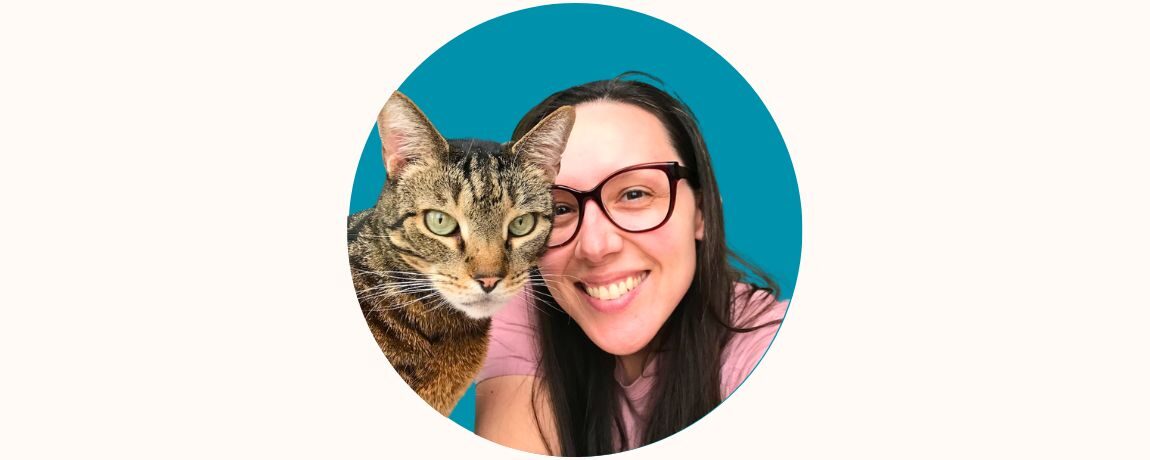Kibble is bad for cats because it is very high in carbohydrates. Cats are obligate carnivores and cannot tolerate large amounts of carbohydrates.
Veterinary nutritionists don’t recommend kibble for cats because it can lead to obesity, certain cancers, FLUTD, and other serious health issues in the long run.
I’ve learned the hard way over and over again the dangers of feeding dry food only. All of my cats growing up ate dry food only, and they suffered.
Diabetes, liver disease, cancer, stroke, CKD, obesity, and the list goes on.
But now I know that cats need fresh, raw and homemade food to survive and thrive. That’s why I always recommend raw as a pet nutritionist.
I realize that many vets still recommend kibble. It’s the most popular food for cats.
It seems convenient and cheap. But the long-term negatives outweigh the convenience.
Here’s why kibble is bad for cats:
- Cats are obligate carnivores
- Kibble is full of carbs
- Carbs are bad for cats
- Kibble is full of plant-based protein
- Kibble does not clean teeth
- Health risks associated with kibble
- Cats vomit more on kibble
- AAFCO cat food rules
PS – If you’re ready to ditch high carb kibble for a species-appropriate raw diet, my Switch to Raw Blueprint digital magazine is for you!
My Switch to Raw Blueprint digital magazine includes my proven food transition plan, healthy treats & topper recommendations to enhance meals, best cat food brands I feed and recommend as a pet nutritionist, and so much more so you can switch your cat to a healthy premade raw diet easily and confidently.
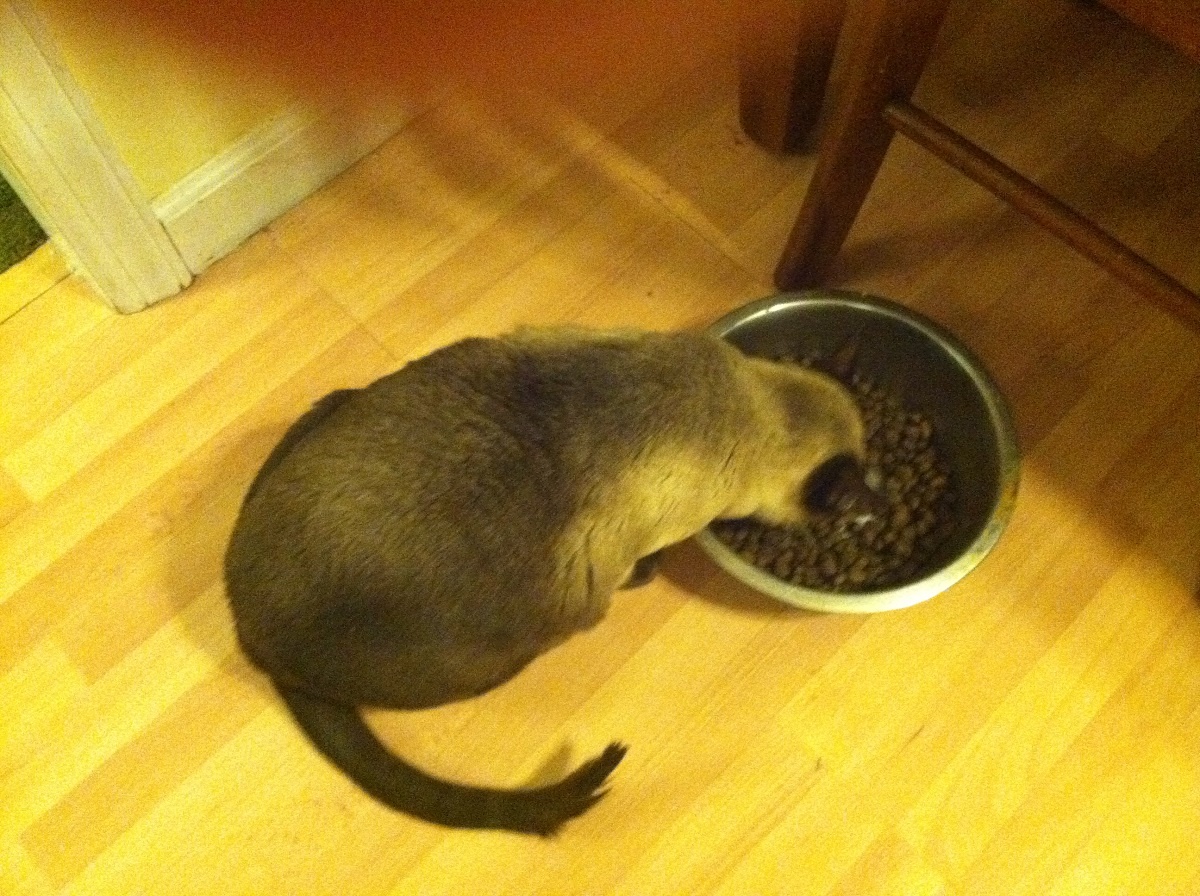
1. Cats are obligate carnivores
I’ve heard that cats are obligate carnivores, but what does that mean?
Carnivore = an animal that feeds on flesh.
Obligate = restricted to a particular function or mode of life.
So obligate carnivore = cats are restricted to a meat-only diet.
Cats cannot survive without eating meat.
Taurine
Taurine is essential to cat health. Cats cannot produce taurine. They must get this from food.
Plants do not contain taurine. Cats must get taurine from meat.
Taurine contributes to:
- Proper growth development
- Healthy eye function
- Immune system
- Heart health
- Healthy GI tract
So, basically everything a cat needs to survive.
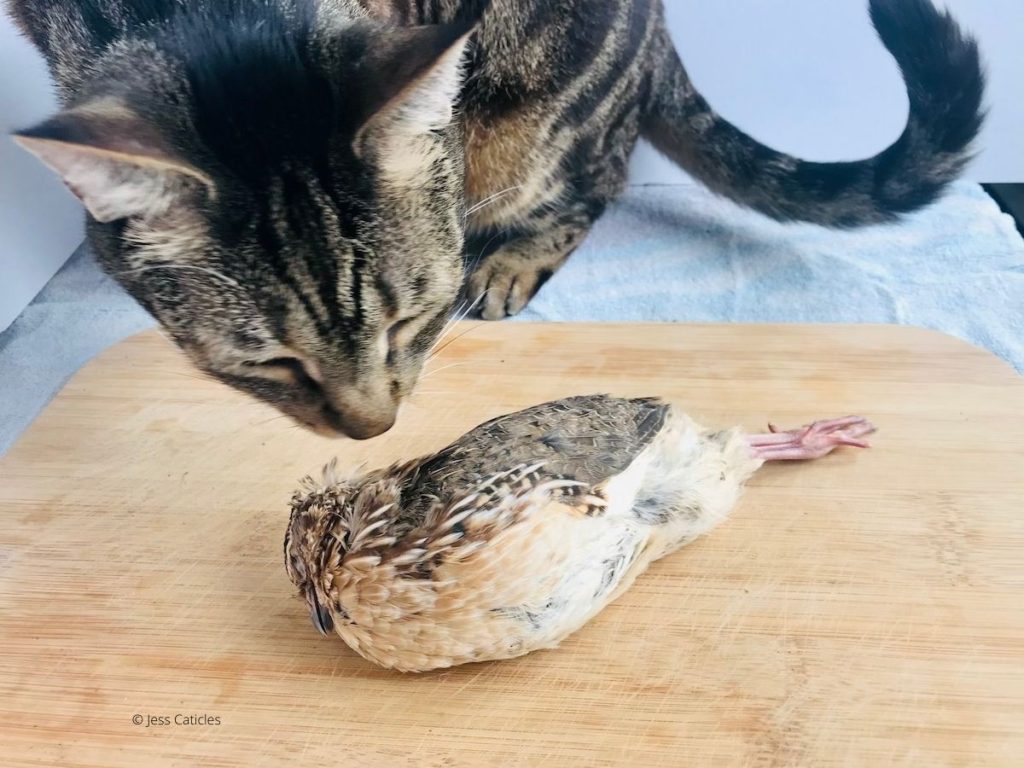
Protein
Animal-based protein is absolutely necessary for cats.
Animal-based protein makes:
- Enzymes
- Antibodies
- Hormones
- Tissues
So, basically everything a cat needs to survive.
Fat
Animal fats and fatty acids are necessary for cats because they provide energy.
Animal fat contributes to:
- Energy
- Nutrient utilization and transportation
- Cell integrity
- Metabolic regulation
So, basically everything a cat needs to survive.
Cats need meat because it is essential to their heart, eye, immune system, cell, and digestive health.
2. Kibble is full of carbs
Most kibble is made through a process called extrusion.
Dried kibble goes through 3 extrusion processes and a coating process.
Carbs and starches are needed to hold the kibble shape.
Otherwise, the ingredients would fall apart and crumble.
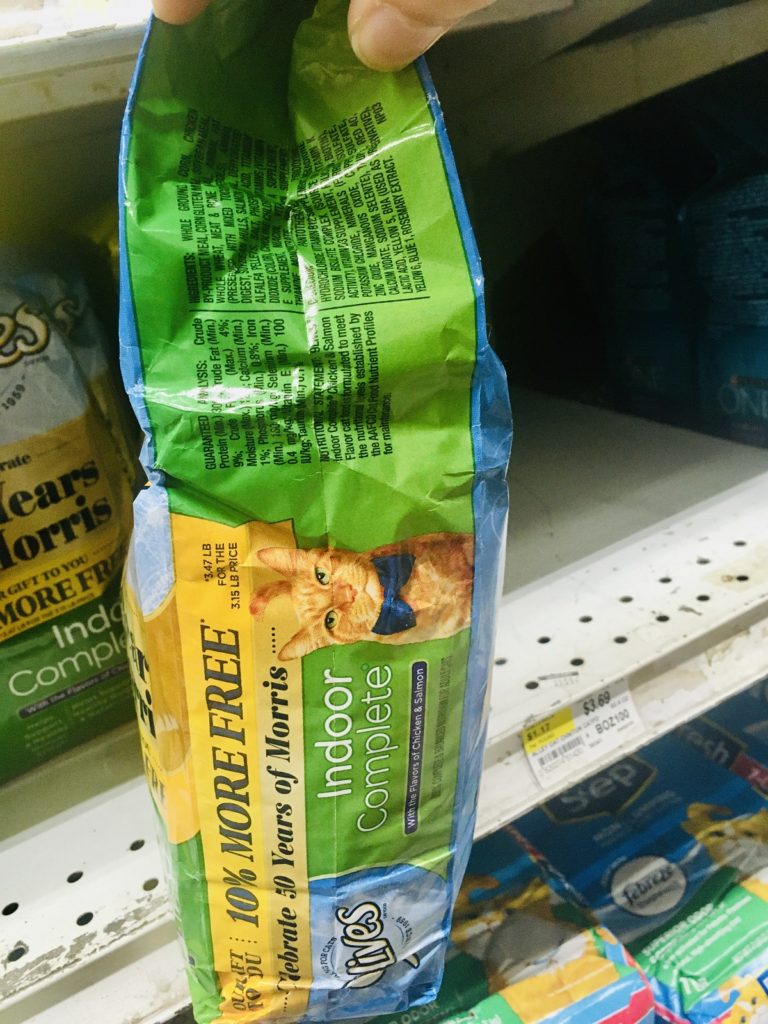
A company called AFB International creates flavor enhancers for kibble.
Pet food manufacturers blend animal fats and meals with soy and wheat grains and vitamins and minerals. This yields a cheap, nutritious pellet that no one wants to eat. Cats and dogs are not grain-eaters by choice. So, our task is to find ways to entice them to eat enough for it to be nutritionally sufficient.
Popular Science the Chemistry of Kibble.
The company refers to one specific flavor enhancer called pyrophosphates as “cat crack.”
Carbs are necessary for kibble to hold its shape. Flavor enhancers are sprayed on kibble because cats don’t naturally eat carbs.
3. Carbs are bad for cats
Wild cats consume whole prey. Their only carb intake would be the stomach contents of their prey.
The cat’s natural diet is typically less than 10% carbs. Kibble is typically around 25-50% carbs.
- Carbs lead to obesity in cats
- Cats cannot utilize carbs
- Carbs and obesity can lead to diabetes
- Cats lack the enzyme amylase in their saliva
- Amylase is responsible for breaking down carbs
- Carbs break down into sugar which causes insulin imbalances
Carbs break down into sugar. This extra sugar spikes insulin levels.
Cats (and humans) build a tolerance to insulin with excessive spikes. Over time, they will need more and more insulin which can lead to diabetes.
In fact, Dr. Elizabeth Hodgkins owns a patent in which she treats diabetic cats.
She explains in her book, Your Cat: Simple New Secrets to a Longer, Stronger Life, that she was able to decrease the need for insulin in diabetic cats just by switching from kibble to a high protein low carb wet food.
Further, two cats that returned to eating dry food developed diabetes again. After transitioning back to high protein low carb wet food, diabetes disappeared… again.
Many vets think that diabetes is incurable.
Important note: If your baby is diabetic I urge you to speak to your vet about Dr. Hodgkins’ patent. This, along with other resources, are included on my diabetic diet for cats page. You must work with your vet on transitioning foods and adjusting insulin levels based on your cat’s blood glucose.
Cats use fat and protein for energy. Not carbs. The cat’s body cannot utilize carbs. And high amounts of carbs in the diet can lead to ill health.
4. Kibble is full of plant-based protein
Most kibble companies use plant-based proteins because they are cheaper than meat-based proteins.
Cats do not require plant-based protein in their diet.
- Plants do not contain essential amino acids Taurine and Carnitine
- Cats need amino acids for healthy body function
- Meat-based protein does contain essential amino acids
Less costly plant proteins don’t contain amino acids sufficient for the nutritional needs of carnivorous dogs and cats.
Dr. Karen Becker
Kibble companies only use plant-based proteins because it’s cheaper than meat-based proteins.
5. Kibble does not clean teeth
I’m sure you’ve heard that kibble cleans teeth because it’s crunchy.
What if your friend said this to you…
“I don’t need to brush my teeth because I eat granola. Granola is crunchy and cleans my teeth.”
Does that make sense?
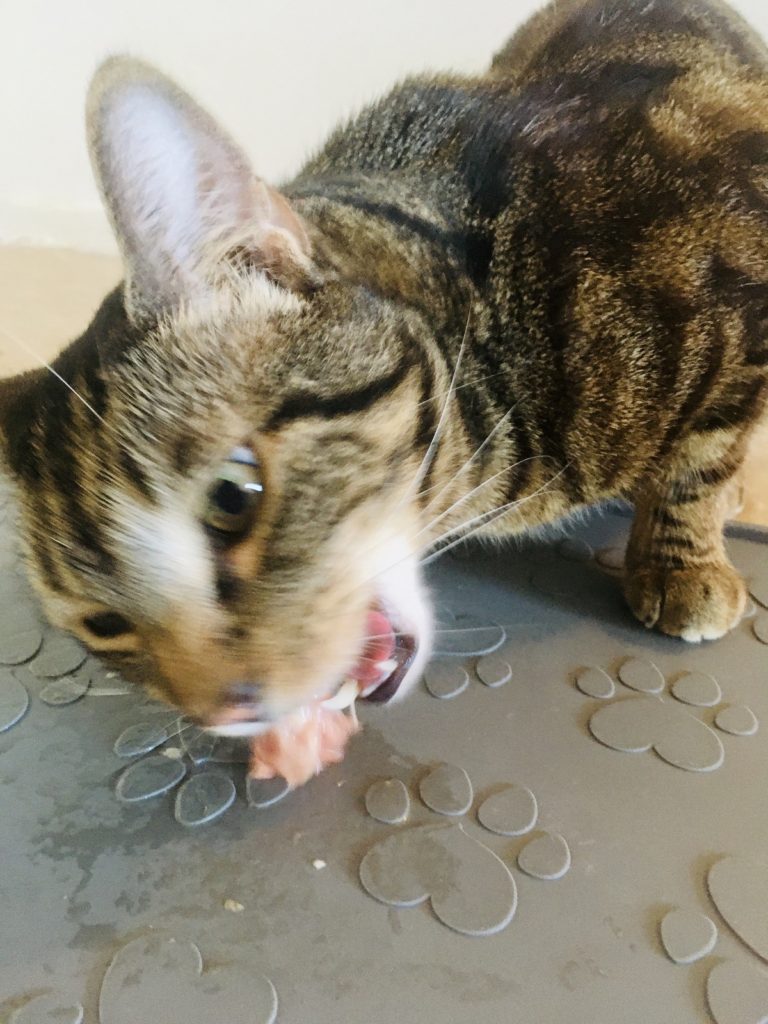
Kibble doesn’t clean cat teeth because it’s full of carbs.
- Cats lack the enzyme amylase in their saliva
- Amylase breaks down carbs
- Carbs are not broken down in the cat’s mouth
- Carbs stick to cat’s teeth and form plaque
- Plaque hardens into tartar
Cats barely chew their food anyway.
- The cat’s jaw moves up and down only
- Our jaw moves up and down and side to side
- The cat’s jaw is designed to chew flesh and bone into smaller pieces
- Those pieces are swallowed whole
- Our jaw is designed to grind food down into tiny pieces
- We don’t swallow food whole
Dr. Lisa Pierson of catinfo.org focuses specifically on the health risks associated with dry food diets.
My favorite line on her site is, “The idea that dry food promotes dental health makes about as much sense as the idea that crunchy cookies would promote dental health in a human”.
Plus, if kibble did actually clean teeth…
Why would kibble companies go through the trouble of creating separate “oral care” kibble diets?
Kibble does not clean cat teeth because it contains carbs. Cats cannot break down carbs in their mouth. This turns into plaque and tartar.
6. Health risks associated with kibble
Kibble is dangerous to cats because it lacks essential meat-based nutrients and moisture. Instead, kibble is full of carbs, plant-based protein, and low moisture.
Cats need meat-based nutrients and moisture to survive.
Cats evolve from desert dwellers who have a weak thirst drive. They rely on their food for moisture.
But my cat drinks plenty of water.
Is it enough though?
Cats are dehydrated at 61% moisture. Most muscle meat is around 75% moisture.
Dry food contains (on average) 10% moisture.
That means the average cat that eats kibble only needs more than 8 ounces of water per day to stay hydrated.
Does your cat drink that much?
The cat’s lack of a strong thirst drive can lead to low-level, chronic dehydration when dry food makes up the bulk of their diet especially if they have any level of kidney insufficiency.
Dr. Lisa Pierson
Health risks associated with kibble include:
- Diarrhea
- Vomiting
- Liver disease
- Kidney disease
- Obesity
- Heart disease
- Feline lower urinary tract disease
- Dehydration
Obese cats have less energy, can develop grooming issues, and live shorter lives.
Check this body condition score chart to see if your cat is an ideal weight.
The health risks of kibble far outweigh the “convenience” of feeding it.
7. Cats vomit more on kibble
I’ve cleaned tons of cat vomit working as a cat sitter.
Have you noticed kibble puke looks the same as it went in?
Vomit is the body’s defense mechanism when we eat stuff our body thinks is harmful.
- Cats rarely chew kibble
- Kibble has low water content
- Dry kibble swell in the stomach
- Swelled kibble exceeds the capacity of the stomach
- This sends signals to the vomiting center of the brain
Cat vomit is not normal. Just because it happens a lot, it doesn’t make it normal.
Cats can also develop allergies to the many low-quality and inappropriate ingredients in kibble. Not to mention the microscopic storage mites that live inside the bag.
Cats vomit kibble because the body sees kibble as a threat.
8. AAFCO cat food rules
AAFCO has many rules when it comes to pet food names and the ingredients list. It’s important to understand these rules.
Otherwise, you have no idea what you’re buying.
The FDA and AAFCO do not regulate the quality of pet food. They regulate the product labels.
AAFCO does not approve cat food.
The pet food label contains a wealth of information, if one knows how to read it. Do not be swayed by the many marketing gimmicks or eye-catching claims. If there is a question about the product, contact the manufacturer or ask an appropriate regulatory agency.”
FDA on pet food labels.
It is our responsibility to find healthy cat food. Not the AAFCO’s or FDA’s responsibility.
I highly suggest studying these rules. Check my cat food label guide.
Did you know carbs are not required in the guaranteed analysis?
Doesn’t that further prove that carbs are not essential? I mean, if they were essential, they’d be required on the label, right?
Technically, carbs are one of the macronutrients. So why wouldn’t AAFCO require this on the GA?
You’ll have to use a carb calculator to figure out the carb amount yourself.
But my cat is too picky to eat healthy food
Sandra had two kibble-addicted cats. Dirk is older and started to gain weight. Avery was young and healthy, but she had very picky eating habits.
Dirk had trouble jumping to his favorite spots, and Sandra started to worry that he would develop diabetes. And she didn’t want Avery to be a picky cat her whole life!
So Sandra started researching about cat food.
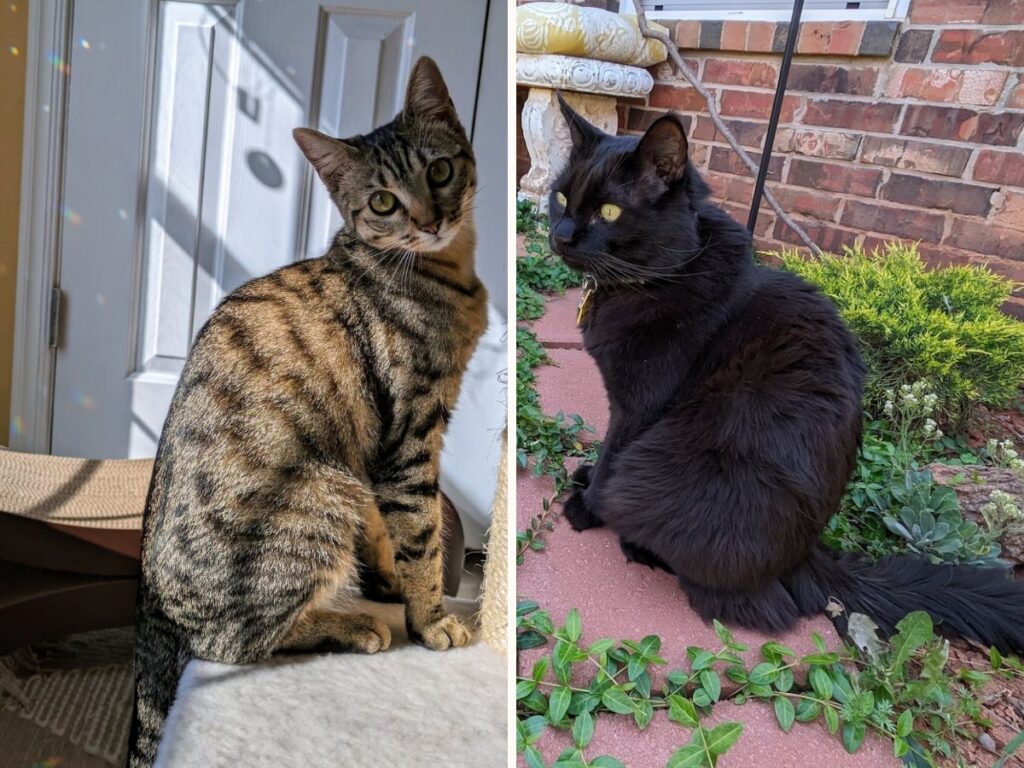
Sandra thought wet food would help because it is healthier than dry food.
But then she discovered raw feeding, and “it all started to make sense! This is what they eat in the wild, and would make them feel their best!!!”
She was excited to try raw, but she knew so little about how to transition them to this diet. And she didn’t know what to give them in the quantities they needed to be healthy.
Then Sandra found me and my course. She became a course member, and she followed my signature PURR blueprint.
My signature PURR blueprint works with your cat’s natural instincts. So you can focus on having fun with your cat instead of feeling stressed and overwhelmed dealing with a picky cat.
Sandra said, “This was such an indispensable tool. It eliminated any fears, or questions I had about the transition, making everything feasible, easy to understand and convenient.”
And now Dirk and Avery (previously two kibble-addicted cats) enjoy a lightly cooked homemade diet! Sandra doesn’t worry about them not getting the nutrients they need. She’s confident that what she’s feeding is the best.
On top of that, Dirk lost weight naturally (no starving) and he’s more energetic and playful.
Sandra felt close to her cats before starting this journey. But her connection and bond with her cats is much stronger now than it was before.
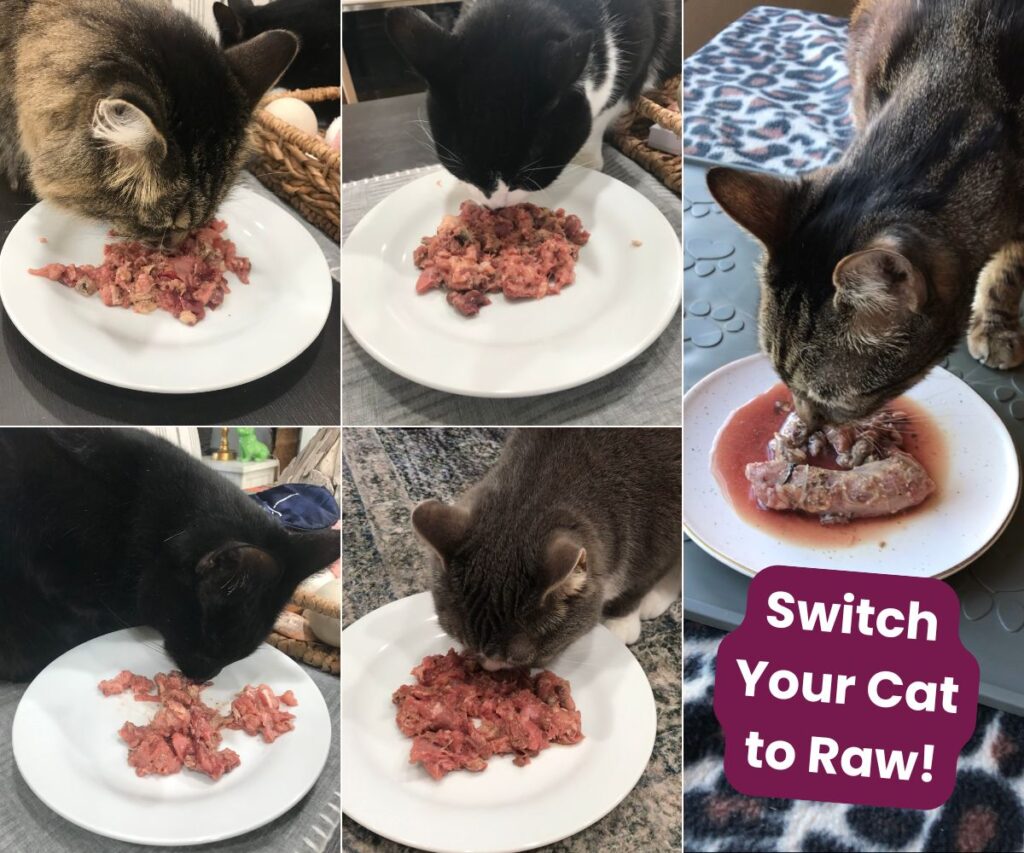
Sandra and her cats have shown us that our cats need more real, fresh food. Processed foods are inconsistent and cause more problems than it’s worth.
But healthy homemade cat food gives us complete control. We control the ingredients, the quality, and how it’s made.
And it’s amazing to see the results of a healthy homemade diet!
Sandra (and hundreds of other cat parents I’ve worked with) feel more empowered to know what’s good and what should be avoided for their cats.
And their cats are healthier because of it!
Ready to switch to raw for a happier cat?
Grab my Switch to Raw Blueprint digital magazine and get the same plan that 564+ cat parents used to switch to a healthy premade raw diet easily and confidently.
